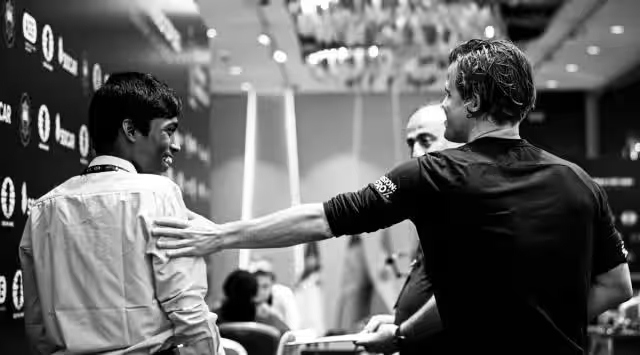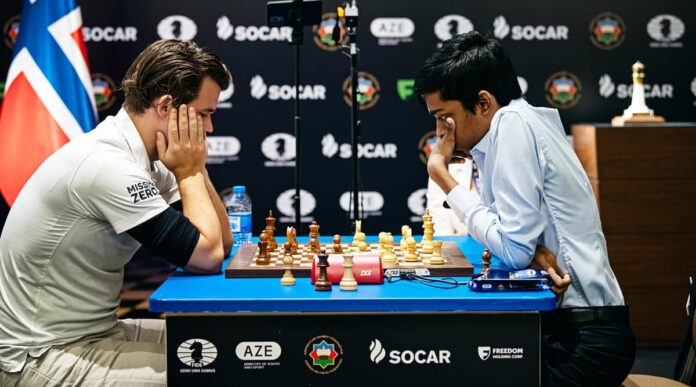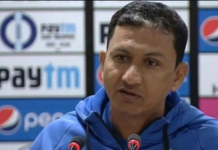R Praggnanandhaa’s dream run at the FIDE World Cup in Baku ended on Thursday, as World No. 1, Magnus Carlsen, defeated him 1.5-0.5 in the tiebreaker to lift the chess title.
After the first two games in the classical format were drawn, Carlsen needed just two games in the shorter time control of 25 minutes in the tiebreaker to prevail on Thursday.
This is no small feat: PM Modi leads wishes as Praggnanandhaa takes 2nd place at Chess World Cup
Pragg, who turned 18 during the World Cup, is the youngest finalist ever. The teenager from Chennai, who was seeded 31, now also holds the distinction of being the lowest seed to make it to the final.
Before he pushed Carlsen to the tiebreaker, Pragg ended the campaigns of World No. 2 Hikaru Nakamura and World No. 3 Fabiano Caruana. He is now assured of a spot in the eight-man Candidates Tournament (which is held to find a challenger to the reigning world champion).
Top Indian cricketers, including Rohit Sharma and Virat Kohli, to undergo fitness test at Alur camp
Growing up in the shadow of his sister, Vaishali Rameshbabu, a local chess champion, Pragg began playing the game when he was three years old. Displaying exceptional skills at a very young age, he became the world’s youngest International Master in 2016, when he was still 10 years old. He became a GM at the age of 12 in 2018, the second youngest player to do so at the time. And he reached the 2600 mark in the ELO rating at the age of 14, once again a world record at the time.
However, a World Cup title eluded him on Thursday. Carlsen proved to be just too experienced. The Norwegian won the first tiebreaker with 47 moves despite playing with black pieces. Just a day ago, playing with white, he had chosen to push for a draw in the second classical game, in a ploy that five-time World Champion Viswanathan Anand likened to the tactics Carlsen had employed against Sergey Karjakin in the 12th game of the 2016 World Championship battle.
Magnus Carlsen reveals he suffered food poisoning after semi-final win at FIDE World Cup
 After Game 1 ended in a draw on Tuesday, Wednesday’s Game 2 also ended in a draw, with Carlsen pushing the game to a stalemate from the start so that he can take his chances against Praggnanandhaa in the tiebreaker. (FIDE/Stev Bonhage)
After Game 1 ended in a draw on Tuesday, Wednesday’s Game 2 also ended in a draw, with Carlsen pushing the game to a stalemate from the start so that he can take his chances against Praggnanandhaa in the tiebreaker. (FIDE/Stev Bonhage)
If he was feeling any aftereffect of the food poisoning he suffered after his semi-final win over Nijat Abasov, Carlsen did not show it on Thursday.
He was his ruthless self against Pragg, noticing the teenager had waded into time trouble in the first tiebreak. He responded by complicating things on the board and simultaneously flooring his foot on the pedal, as he played with the urgency of a man driving an ambulance. He almost blitzed his moves at the end, leaving Pragg no breathing space to think of a stouter defence. Carlsen pushed until Pragg finally yielded. In the second game, Carlsen forced a draw to seal his win.
Before Thursday, the Norwegian boasted of a formidable resume: five-time world champion in the classical format, four-time rapid world champion, six-time world blitz champion, and World No.1 since 2011. But the World Cup title was missing. Right after his win over Pragg on Thursday, he tweeted with a GIF that declared he had “completed chess”.
Magnus Carlsen reveals he suffered food poisoning after semi-final win at FIDE World Cup
The triumph comes at a time when Carlsen’s career is at the crossroads. Earlier this year, he chose to abdicate his right to defend his position as the world champion. Consequently, the 32-year-old was replaced by Ding Liren, the first time since 2013.
 Magnus Carlsen won the first tiebreaker with 47 moves despite playing with black pieces. (FIDE/Stev Bonhage)
Magnus Carlsen won the first tiebreaker with 47 moves despite playing with black pieces. (FIDE/Stev Bonhage)
The reasons Carlsen gave were pretty straightforward: lack of motivation and not wanting to put himself through the rigours of another campaign.
On Thursday, he was asked by Chess24 if the World Cup triumph had changed his relationship with classical chess. “I wouldn’t say it increases the chances that I will play this again. Winning the World Cup wasn’t really a thing for me before 2017. After I did so poorly, I thought I cannot let this be my legacy for the World Cup,” he responded.
He suggested that he competed at the World Cup to prove a point. “If it was very clear from my results in classical chess that I’m still comfortably the best player in the world, I wouldn’t have played here,” he said.
“Almost since the first day (of the World Cup) I’ve been wondering, what am I doing here? Why am I spending all this time playing classical chess, which I find stressful and boring? It’s not a good state of mind,” Carlsen told FIDE’s YouTube channel earlier.
The loss to Vincent Keymer earlier came as a wake-up call. In 2017, he had suffered an early exit when he lost to World No 35 Bu Xiangzhi in the third round. “My thoughts were, if I lose and go out, that’s going to be another humiliation in the World Cup. I know I’ll forget about it in a couple of days, but it’s still less than ideal. Now I’ve had my first serious scare,” Carlsen said.
That scare seemed to whet his appetite for classical chess. In the last-16 encounter against Vasyl Ivanchuk, Carlsen rejected a draw offer from his Ukrainian opponent in the second game, despite not needing to win since he had won the first one.
Against Nijat Abasov in the semi-final, he turned up early, and gave the world the now-viral clip of him offering his hand to an empty chair across the board. He started the clock of his opponent, who was a few seconds late, and then waited. “It was a joke,” he said later.
But, as it turns out, he was deadly serious about winning.
.








